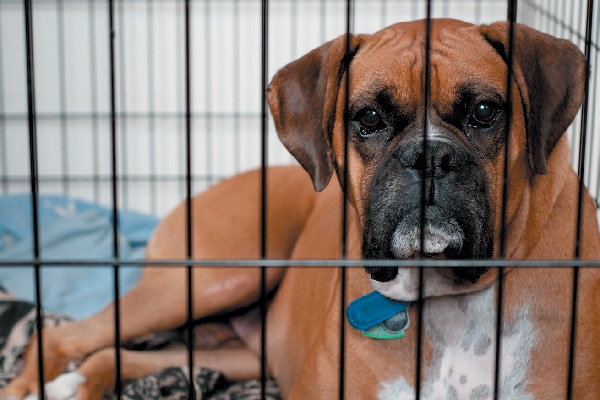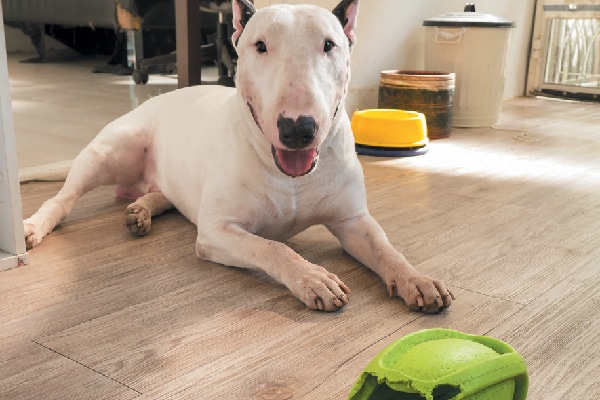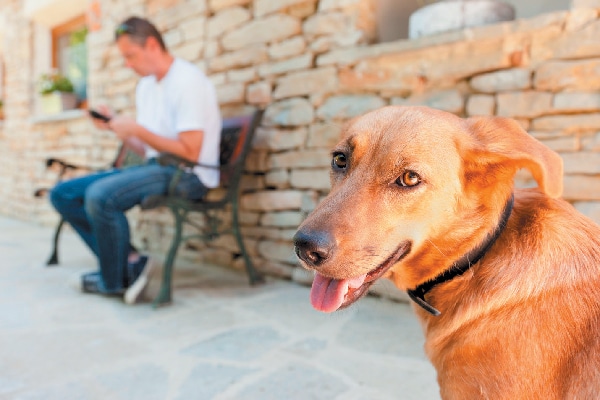We always want to do what’s best for our dogs, yet sometimes we unintentionally cause undue stress, thinking we’re doing the right thing. Want to make sure you’re on the right path with how to take care of a dog? Check out these nine big things you should know to never do when it comes to how to take care of a dog.
The 9 Things You Should Never Do When Taking Care of a Dog
1. Label dogs as stubborn, hyperactive, out of control or stupid and then punish them for it

This is one of the worst things a dog guardian can do. Dogs who are labeled bad dogs or have so-called bad behaviors are usually dogs who haven’t had the time put in with training and exercise. If a dog exhibits unwanted behaviors (not bad behaviors), it’s because they haven’t been taught what it is that you do want.
When dogs express unwanted behaviors like jumping on people or furniture, mouthing you, barking, pulling on the leash, etc., they are expressing some kind of anxiety or frustration.
What can you do? Take the time to teach the wanted behaviors along with exercise, which will go a long way to setting a solid foundation of trust and mutual respect.
2. Tether a dog
People tie their dogs up to a post in a public area when going to the store, coffee shop or even a park. This may seem like it’s one of those things that seems pretty benign.
However, dogs can get their legs wrapped up in the leash — and being unable to free themselves — chew the leash, trying to get free and, once free, they can be hit by a car, get lost, stolen or bite someone out of fear.
Also, many dogs are anxious when left alone in public. People often think, especially children, if a dog is tied up in public, she must be friendly and try to pet the dog. This leaves the dog vulnerable to strangers, making her more anxious, which is an opening for a potential dog bite.
There is also tying your dog up (tethering) at home. You might think it more humane and fun to leave your dog in the yard while you do errands for a couple of hours, rather than tucked away safely in your home. After all, fresh air and room to frolic would be great for a pup, right? Think again! Even if your yard is safely and securely fenced, dogs are vulnerable to things that can frighten them.
They’re vulnerable to wildlife, unfamiliar sounds and strangers passing by and, if frightened and no one is there to help, they may try to dig out of the yard or try to get back in the house, causing damage to your property and to themselves.
A pup who’s suffered a traumatic event while left alone can develop behavioral issues, like barking, separation anxiety, fear of noises and people, etc., later in life.
Dogs left out in the yard are also exposed to the weather, especially when it’s too hot or too cold. There are now laws against tethering your dog for any length of time in some cities, counties and states.
Also, dogs tethered outside may bark at other dogs, neighbors and all sorts of neighborhood noise. The pet guardian is accountable for this and there are many nuisance pet ordinances in neighborhoods, which can leave you open to being fined or having Animal Control pay you a visit.
What can you do? Keep them indoors safe and secure; either in a safe enclosure, like a crate or exercise pen, or your dogproofed home.
3. Not supervising playdates
Dog playdates are a necessary part of a puppy’s life, yet we as their advocates need to be present to ensure that the play is fair and doesn’t last too long. If the pup becomes overtired it can lead to a negative experience toward dogs.
Proper dog socialization isn’t a haphazard affair. Never drop a puppy off at someone’s house for a couple of hours, thinking they’ll supervise like you would.
What can you do? Find the right match for your puppy, and pay attention so you know when your pup has had enough. This will go a long way to having an adult dog who loves other dogs instead of one who may become aggressive.
4. Poison the “come” cue
Never call your dog to “come” to you when she’s done something wrong. If your dog has behaved inappropriately and you yell “Come” at her, you’ve just poisoned the “come” cue and wonder why she doesn’t respond when you call her.
What can you do? When using the word “Come,” always follow with praise, high-value rewards and a happy voice.
5. Stop giving toys

Does your dog destroy every toy you give her, so you’ve just stopped giving her dog toys? Dogs get through life by their noses and their mouths, especially puppies. They need to chew, and every dog has different chewing habits.
We can’t just stop giving them toys — we must still meet their chewing needs without being destructive. Many dogs become destructive chewers because we aren’t offering an interactive routine of mental and physical stimulation. Leaving them to their own devices creates boredom, and bored dogs generally develop unwanted behaviors like destructive chewing.
What can you do? Voracious chewers need things like puzzle toys that have treats hidden inside, offering hours of fun mental stimulation. Marrow bones are another healthy alternative for those insatiable chewers and, when they’ve thoroughly cleaned them, you can stuff them with food and freeze them so you’re always prepared to meet their needs.
6. Use crates instead of training manners
Crates can be a wonderful training tool, but they are often misused for our own convenience. Putting dogs in crates so they aren’t in the way when company comes or we’re doing chores is doing a disservice to dogs. They want to be part of the action and if they’re crated, they can’t learn manners.
What can you do? Use the time doing chores to teach your dog how you want her to behave rather than locking her away. Keep her on a routine training and exercise program to help her be more trainable in distractions.
7. Use our hand for anything but praise and gentle touch
Hitting a dog makes her afraid and will break whatever trust you’ve built. Fearful dogs can and will bite if they feel threatened. Someone reaching out to pet your dog could be seen as a threat if you’ve used your hand for punishment.
What can you do? Take the time to teach her what you do want rather than punish what you don’t want. Think of your hand as an extension of your heart, and watch your dog melt in your hands.
8. Dogs riding in the back of a pickup truck

There’s nothing that makes me crazier than when I see a dog in the back of a pickup truck. Tethered or not, the open bed of a pickup truck is dangerous, no matter what. We wouldn’t put our children back there, why would we put our dogs back there?
If you have to stop short or swerve out of the way, the dog will be catapulted out of the truck into traffic, which will most likely cause another accident and the probable death of the dog. If the dog is tethered, she will then be hanging over the side of the truck.
Either way, it’s wrong and illegal in many states — as it should be. As our dogs’ advocate, we are responsible for making wise choices, and this one is not a wise choice.
What can you do? Check out the Center for Pet Safety for tips and information on harnesses and crates that have been crash-test certified.
Read more about why you should never put a dog in the back of a pick-up truck >>
9. Not take a dog in for an annual vet checkup and blood tests
We should never neglect our annual wellness exams, especially as our dogs age. Even if your dog’s core vaccines are good for three years (see guidelines at aaha.org), they still need annual checkups to include blood work.
Earlier detection of disease means that treatment can be started earlier, increasing your dog’s chance of a better outcome.
What can you do? Take your dog in annually for adult dogs and more frequently for puppies and seniors.
The bottom line on how to take care of a dog — the right way:
Remember, dogs have emotions and need our guidance to help them navigate life in our human-dominated world.
Award-winning writer Jill Breitner has been training dogs since 1978. Her passion lies in teaching people about dog body language. Jill created the Dog Decoder app (available in Google Play and iTunes) as a way to enhance the human-dog bond by understanding them better. You’ll find her at play near the ocean. Follow her at dogdecoder.com, facebook.com/dogdecoder and on Twitter at @shewhispers.
Read more training a dog properly:
- 6 Things to Remember When You Have a Fearful Dog
- 7 Steps to Succeed at Loose-Leash Walking
- Think You’ve Got a Stubborn Dog? How to Train a Dog Who Won’t Listen
Featured Image Credit: Cultura Creative | Alamy Photo.





